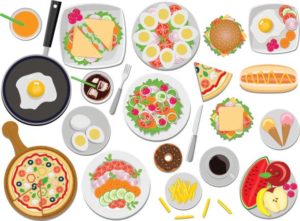
How to Read the Nutrition Facts Label
Part of maintaining a healthy diet is to really understand what you are eating. To do that, you need to understand how to read and comprehend the nutrition facts on all of the cans, boxes, wraps, and other packaging your food comes in. As a college student, this most likely comprises 95% of the food you buy. The following information is to be used to make informed decisions and healthy choices when choosing the food to buy/eat.
We will start from the top and make our way down. The first bit of information we see is the number of servings in the package and the number of servings per container. For a box of mac and cheese, the serving size is 1 cup and the servings per container are 2. This means that for each nutrient value below it, it is referring to the one cup serving size. If we wanted to know how much of something was in the whole package we would have to multiply it by two because there are 2 servings in the entire package. Be sure to keep this in mind as you read the rest of the nutrition facts and apply them to how much you plan on actually eating.
This can be tricky sometimes, especially with junk food like potato chips or cookies. The nutrition facts will give you a certain number of calories which might not seem too bad but when you look at the serving size, it could be close to four chips or a couple cookies. This means you’d have to multiply the calories by the number of servings you’ve eaten which can add up quickly because people rarely open a bag of chips just to eat four.
The calories listed determine the amount of energy you will get from eating one serving of that particular food. Be conscious of the statistic next to it: “calories from fat.” This will tell you how many of the total calories in each serving come from fat alone. It is ideal to keep this number low; as seen in the example, almost half of all the calories per serving are from fat.
The nutrients in beige are the values you want to limit in your diet. These are the nutrients that college kids generally eat too much of. They can lead to sickness and other diseases such as heart disease or high blood pressure later in life. When buying foods that are processed or have long shelf lives such as macaroni and cheese, be aware of the levels of sodium in the package. Eating this whole package would constitute almost half of your recommended amount of sodium intake for the day. High sodium levels will become much more of a concern when you are older but better to practice good habits at a younger age.
The nutrients in blue are the nutrients that you want to be sure you get enough of. These are often the nutrients that college kids lack in their diet. These nutrients such as vitamin A and C, calcium, and iron are vital to improving ones health and reducing the risk of the diseases mentioned above. Calcium for example helps with bone strength which is often a concern as you grow older. The calcium content in this box of mac and cheese constitutes almost half of the daily recommended value, likely due to the level of cheesiness.
The percent daily value (%DV) is often the part of the nutrition facts that people find most difficult to comprehend. The %DV is based on a 2,000 calorie diet, a standard set by the FDA. Whether that is an accurate figure as to how many calories you actually consume a day, the %DV can still be a reliable reference as to the daily value of a certain nutrient. It is calculated based on the number of grams of each nutrient present in the package. For the nutrients in beige, it is acceptable to fall below 100%DV in a day. For those nutrients in blue, it is ideal to average 100%DV each day. Be mindful that this too is affected by the number of servings in a package. The %DV doubles if you were to eat this whole box of mac and cheese.
As a general rule of thumb, 5%DV is considered very low and 20%DV is considered very high for any nutrient. As you can see with the %DV of total fat in the package, 18%DV falls just below the 20% limit. If you ate the whole box, however, that %DV jumps to 36%. That’s a high percentage of your total daily fat intake, leaving you only 64% left for the rest of the food or drink you ingest for the rest of the day.
You will notice that neither sugars nor protein have a %DV. No recommendations have been made for ideal levels of sugar. The amount listed includes many of the naturally occurring sugars on food but can get tricky when discussing the level of sugar added to certain foods. Consult the ingredients list to know for sure. Protein currently has no scientific evidence that it poses concern for public health. The only time a %DV is listed for protein is when the producer of the food makes a claim to be “high in protein” or the food is meant for children under the age of 4. Otherwise, none is needed.
Finally, the white box (or footnote) at the bottom of the nutrition facts label is not specific to the product. The statement after the (*) is required to be present on all food labels. The information underneath that may not always appear due to available space on a package. These are daily values relevant to all Americans and simply state recommended amounts of each nutrients based on a 2,000 or 2,500 calorie diet.

